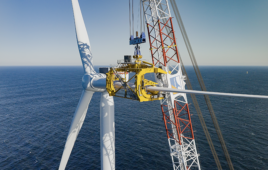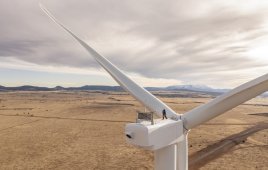Despite the recent surge in wind-turbine announcements regarding direct drives, gearboxes are not going anywhere. They will remain a necessary component in many wind energy turbines and so are also pushing trends in several directions—toward lighter overall turbine weight, improved durability, and design for maintenance.
“After ten years of research and study, we know why the early gearboxes did not stand up well to the duty hazards in wind turbines,” says Timken’s Hans Landis, Director, Process Industries OE & Wind Energy. “And those lessons have been disseminated throughout the gear industry.” The lessons Landis refers to start with a better understanding of the loads on a wind-turbine gearbox. For instance, the constant pounding of the wind on the rotor and main shaft of older designs could slowly hammer away at the gearbox. Higher loads there would slowly damage bearings, then gears, and eventually require a gearbox swap. More recent designs let better bearings handle loads so gearboxes need not.
Early main shaft gearboxes on kilowatt-sized machines were off-the-shelf industrial units with minor modifications. The obvious gearbox trend is that they have gotten bigger with megawatt outputs, and each is designed for its turbine model. “There are no off-the-shelf designs today,” says Mike Carlson with Hanson Transmissions. He explains that each is designed for the turbine platform and in collaboration with the OEM. Inside, the slow, high-torque rotor speed is initially stepped up with a planetary stage followed by two more stages. Generally below three megawatts, the second or intermediate stage uses helical gears. But three-megawatt-and-larger turbines need a planetary design in the second stage and a helical stage for the high-speed output. If OEMs continue designing larger turbines, that last stage will also use a planetary design.
Ways to ease maintenance have also gotten attention. “Although not all maintenance will be possible in a cramped nacelle, more than what was previously possible will be,” says Carlson.
Romax, a developer of software for gearbox simulations, sees a trend to integrate the bearings, which support the main shaft and rotor into the gearbox itself. This can have significant advantages and reduce the overall drivetrain size. It also allows reducing gearbox stresses due to high rotor loads.
The market is seeing more integration between gearboxes and generators. This again has advantages in terms of overall size, weight, and cost. In some cases, the number of bearings can be reduced in the drivetrain and the gearbox consists of just one or two planetary gear stages with no high-speed shaft.
Several years ago, for example, a study released by NREL showed that a combination medium-speed gearbox and permanent-magnet generator would provide the lightest weight drivetrain. That may have started turbine manufacturers considering such medium-speed drivetrains for large wind turbines, typically for 3-MW machines and larger. Medium-speed drivetrains use larger, more costly generators which run at lower speed but with the advantage of reducing gearbox cost and complexity. Fewer gears and bearings are involved in the design. Medium-speed gearboxes typically consist of one or two planetary gear stages and have ratios between 1:7 and 1:35.
Cooperation is another trend across the wind industry. For one, Moventas, a manufacturer of gears and gearboxes for turbines, and The Switch, a supplier of megawatt-sized permanent magnet generators and converters, now offer a combined gearbox and PM generator that is smaller and lighter than a conventional drivetrain of similar output. “The lower the nacelle weight, the more cost competitive the turbine,” says Moventas CEO & President Jukka Jäämaa. “Nacelle weight relates directly to foundation and construction costs of the turbine, as well as manufacturing, transport, and assembly costs in the whole supply chain.” WPE
Filed Under: Components




